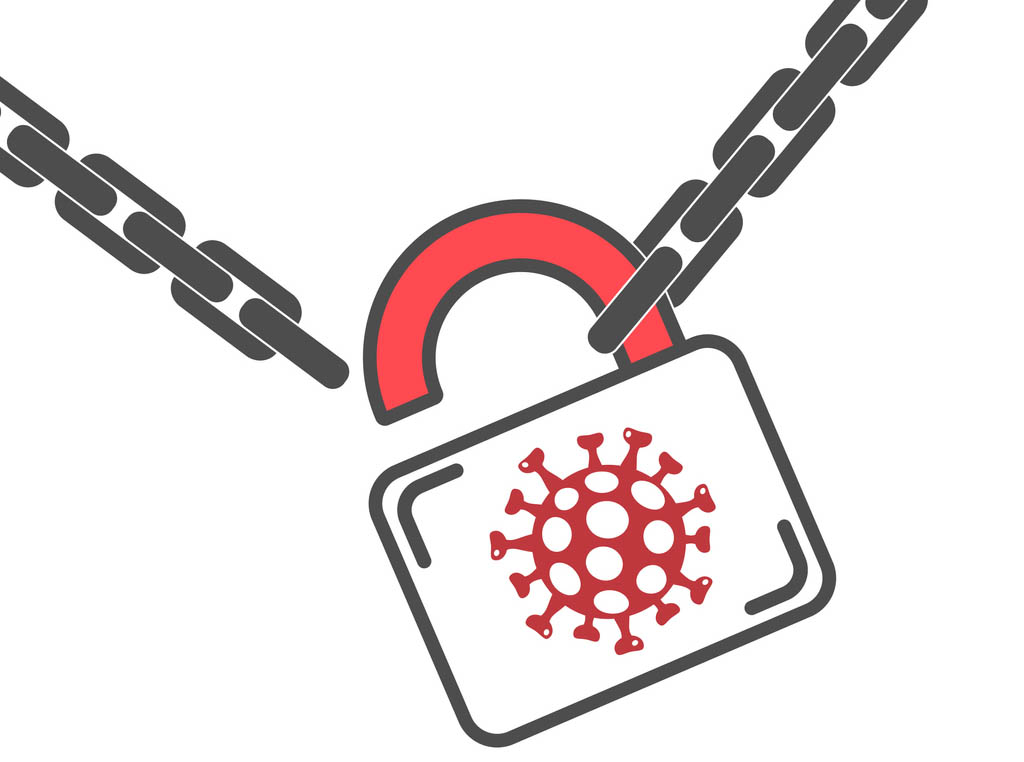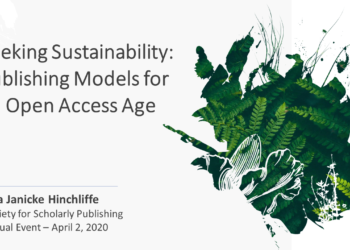Editor’s Note: Today’s post is by Leigh-Ann Butler, Shannon Cobb, and Michael Donaldson. Leigh-Ann is a Policy Analyst at the Natural Sciences and Engineering Research Council of Canada (NSERC). Shannon is a Science Policy Advisor at the Canadian Institutes of Health Research (CIHR) and was formerly a Policy Analyst with NSERC. Michael is an Open Access Specialist with Canadian Science Publishing, and an Adjunct Professor in the Department of Biology at Carleton University.
COVID-19 has demonstrated how quickly the research ecosystem can come together to respond and share research results on a global scale. Since the current system is not open by default, stakeholders in publishing, academia (including libraries and administration), and research funding have had to reactively change their policies to enable rapid access to, and dissemination of, scientific information and research results to respond to the current pandemic.

COVID-19 is not the first global health crisis to demonstrate the critical role open access plays in disease response, containment and prevention. In 2015, a group of scientists working on the Ebola pandemic published a letter attributing the slow response to detecting the disease to a closed and inequitable research system. The authors highlighted how a pay-walled 1982 article hid crucial findings of the existence of Ebola antibodies within the Liberian community, proving it was not “a new phenomenon” as once thought. (Editor’s Note: the nuances of this complex situation were discussed in several Scholarly Kitchen posts, including “Discovery and Access in Light of the Ebola Outbreak” and “Access Alone Isn’t Enough: Revisiting Calls for Discovery, Infrastructure, Technology, and Training“). The COVID-19 pandemic and associated calls for immediate open access demonstrate that paywall barriers remained in place despite past lessons, preventing access to critical information.
In this two-part series (Part 2 available here), one of Canada’s federal scientific research funders (the Natural Sciences and Engineering Research Council of Canada – NSERC) and largest STEM publisher (Canadian Science Publishing – CSP) are collaborating because, as a funder and a publisher, we recognize that we are part of the same complex scholarly research ecosystem. We need closer collaboration to move towards a more open, sustainable, and equitable publishing environment. We will draw on the expert opinions of Canadian stakeholders about the impact of COVID-19 on open access (OA) and scholarly publishing and, national and regional policies to advance science for the public good. We propose greater collaboration among all stakeholders in the scholarly publishing system, to make sustainable changes for greater equity and openness.
Open Access publishing and policies in Canada
Canadian research is financed by various domestic (federal, provincial, not-for-profit, etc.) and international funding bodies. The open access policies of funders and post-secondary research institutions vary, although in Canada most center on a 12-month period for an author to make their publication publicly available. For example:
In February 2015, the three federal granting agencies — NSERC, the Social Sciences and Humanities Research Council (SSHRC) and Canadian Institutes of Health Research (CIHR) — launched the Tri-Agency Open Access Policy on Publications which requires agency-funded researchers to make their published research articles publicly available (in an OA journal and/or online repository) within 12 months of the official publication date.
In April 2019, the Fonds de recherche du Québec (FRQ – the province of Quebec’s research funding body) released the FRQ OA policy for the dissemination of research which requires articles based on FRQ-funded work to be made freely accessible in an OA journal and/or online repository within 12 months of publication. On June 1, 2021, the FRQ announced it will be amending their OA Policy to eliminate the 12-month embargo by March 2023.
In December 2019, the Université de Montréal adopted an OA policy; the Politique de l’Université de Montréal sur le libre accès aux publications savantes (available in French only). This policy commits all university authors to deposit their peer-reviewed articles, book chapters, and conference proceedings in the university’s institutional repository as soon as they are published. Open access will be provided automatically by the repository no later than 12 months after the date of publication, depending on the publisher’s policies.
Canada’s scholarly publishing ecosystem is comprised predominately of not-for-profit publishers, including scholarly society publishers and university presses. Like many scholarly publishers, Canadian Science Publishing (CSP) is developing transformative agreements to transition subscription content to OA, a shift that carries inherent risk, particularly for small and not-for-profit publishers. Coalition Publica, which develops and coordinates an open national infrastructure supporting research dissemination and digital scholarly publishing in Canada, was awarded a multi-year grant from SSHRC to enhance the dissemination of Canadian social sciences and humanities research and produce incentives and research outputs to encourage open access practices. Coalition Publica’s infrastructure is also supported by funding from the Canadian Foundation for Innovation (CFI).
The Canadian community supports partnerships and collaboration and wants to see an open future, but how can publishers continue to cover their costs? Rowland Lorimer, founding director of the Canadian Institute for Studies in Publishing and a professor emeritus at Simon Fraser University, has long stressed the need for further investment in national journal publishing. In an opinion piece in University Affairs, he states: “In Canada, we need to embrace investment in digital developments focused on journal publishing. Adapting our business-oriented publishing industry support programs to scholarly journal publishing would be a powerful first step. Extending Canada’s publishing support programs to Canada’s research journals would bolster, directly and indirectly, Canada’s participation in the knowledge economy and open a substantial, socially and personally rewarding sector and profession that has been expanding dramatically around the globe over the past few years.” In an OA world, investment is key to ensuring a vibrant national publishing community and robust digital infrastructure, as clearly evidenced by COVID-19.
Open access initiatives during the COVID crisis and beyond
The scholarly publishing community has created a number of initiatives to ensure COVID-19 research reaches scientists, front-line workers, policy-makers and the public around the globe.
For example, over 40 publishers and journals heeded the call from global Chief Science Advisors (and their equivalents) to make all COVID-19 and related research and data openly accessible. The Canadian and global science community also extended calls and statements of support for openness to respond to the pandemic. For example, NSERC, CIHR, FQRNT and Canadian Science Publishing signed the global (Wellcome Trust) joint statement on sharing research data and findings relevant to the novel coronavirus (COVID-19) outbreak. NSERC has also asked that all scientific information related to COVID-19 resulting from research funded by an NSERC COVID-19 grant be made immediately open access; and calls on researchers to consider doing the same for all COVID 19-relevant scientific information, irrespective of how it is funded.
There are hundreds of signatories to this global joint statement; however, there is currently no system in place to ensure compliance. Dr. David Moher, Senior Scientist with the Clinical Epidemiology Program at the Ottawa Hospital Research Institute and Director of the Centre for Journalology,, comments that “there is no public-facing audit and monitoring of whether grantees of COVID-19 research of these organizations are abiding by the funders wishes. Evidence suggests a relationship between monitoring open access policy (an open science practice) and any resulting effectiveness of the practice.”
Stefanie Haustein, Associate Professor at the University of Ottawa’s School of Information Studies and co-director of the ScholCommLab, indicated that declarations like the Wellcome Trust statement are intended to apply “to similar outbreaks in the future where there is a significant public health benefit.” Haustein warns that these measures, “particularly by for-profit publishers, are only temporary.” In regard to policies, Moher raises the point that behavior is often encouraged by incentives (“carrots” versus “sticks”). What exactly is the incentive to meet policy requirements, especially in a time when so many are already overrun by meeting personal and career demands during COVID-19? Moher and Haustein both raise important points. Policies can drive change but they can also delay progress when they fail to evolve. Post-pandemic, it will be important to evaluate the impact of temporary policy changes.
Open science for greater equity, diversity and inclusion
Dr. Mona Nemer, Canada’s Chief Science Advisor, said in her keynote address at the 2020 Canadian Research Knowledge Network Conference, that immediate access to research results, instead of being “blocked behind paywalls, allows for both more equitable dissemination of knowledge and ensures that public health authorities and policy makers make decisions on the most up-to-date evidence.” As Nemer highlights, effective decision making relies on up-to-date and accessible evidence and therefore a more agile system, such as OA.
The question of how we can achieve equitable OA has stimulated much discussion among the scholarly publishing community. The COVID-19 pandemic has further exposed the challenges, but also presents an opportunity to explore how the scholarly process can become more inclusive — where everyone is empowered to contribute knowledge, regardless of their country, social class, visible minority status, gender, and language. To achieve equitable openness, policies and actions need to reflect all ways of knowing and exchanging information. In this sense, as Catriona J MacCallum, Director of Open Science at Hindawi, states, openness serves as a mechanism by which we “can make research more effective, reliable, collaborative, and equitable.”
Open knowledge sharing should include openness to knowledge and systems from all communities. University of Toronto professor Leslie Chan and coauthors wrote a report on this topic titled Open Science Beyond Open Access: For and with communities, in which they state “Contrary to the myth of scientific neutrality, science — steeped in history and culture — has always carefully selected the knowledge to which it will grant the status of “scientific.” This knowledge has to prove that it meets certain normative and epistemological criteria… Such filters obviously lead to exclusion.” In order for knowledge sharing to be effective and increase inclusiveness, scientists must demonstrate respect and engage with Indigenous communities. Open access to research also means designing research outputs to be accessible to a range of audiences (including youth and persons with various abilities), and translation into Indigenous languages.
Knowledge coproduction, in which Indigenous communities and scientists collaborate throughout the research cycle, respects and includes both Indigenous and Western knowledge systems. This is a key requirement for achieving equitable open research. As an example, Canada’s First Nations communities have established Ownership, Control, Access, and Possession (OCAP)™ Principles: “First Nations control data collection processes in their communities. First Nations own, protect, and control how their information is used. Access to First Nations data is important and First Nations determine, under appropriate mandates and protocols, how access to external researchers is facilitated and respected. The right of First Nations communities to own, control, access, and possess information about their peoples is fundamentally tied to self-determination and to the preservation and development of their culture. OCAP™ allows a community to make decisions regarding why, how and by whom information is collected, used or shared.”
Canada’s federal granting agencies (NSERC, SSHRC and CIHR) are committed to ensuring the ethical conduct of research involving Indigenous peoples, including the sharing and dissemination of knowledge [see Chapter 9 of the Tri-Council Policy Statement: Ethical Conduct for Research Involving Humans – TCPS 2 (2018); and the tri-agency strategic plan Setting new directions to support Indigenous research and research training in Canada 2019 – 2022, which fulfills a priority of the Canada Research Coordinating Committee to co-develop with Indigenous Peoples an interdisciplinary research and research training model that contributes to reconciliation]. One of the mechanisms included in this strategic plan is to champion and support Indigenous data management protocols to ensure community ownership, control, and access of Indigenous data and protection of Indigenous intellectual property rights.
Part 2 Preview
In Part 2 of this series, a number of Canadian experts working in the area of OA share their thoughts on the changing state of scholarly publishing in Canada during COVID-19—how the pandemic is affecting the publication process, research funding, and scholarly research infrastructure (e.g., CanCOVID).
Until then, please share your thoughts: What changes in open access/scholarly publishing have you observed during COVID-19, or wish to see going forward?
Discussion
2 Thoughts on "Guest Post — Pandemic Disruptor: Canadian Perspectives on how COVID-19 is Changing Open Access (Part 1)"
Nice post – I hope part two, or separate work in the background also looks at how the OA system in Canada aims to support the pure OA publishers, many of the CALJ (Canadian Association of Learned Journals), OJS/PKP members, and Publishers like JMIR Publications, are native pure OA Canadian publishers and are currently disadvantaged by policies at with the likes of CRKN who support Subscription and Transformative deals, but do not yet seem to have in their mandates to fully support, or understand the changing OA publishing landscape that is evolving in the rest of the world – there’s certain a need for libraries/institutions, funders and Canadian publishers to come together. This jointly written OASPA blog post expresses this sentiment well and I hope can also be taken in context on the bigger changes in Canada and the broader scholarly communications world https://oaspa.org/guest-post-the-fully-oa-agreement-an-essential-component-of-a-diverse-open-access-world/
Thanks for your informative post. In terms of your policy development efforts, it might help to consider these following three points: (1) The term “open access” is used differently by different researchers and institutions. The policies you are describing (like the Tri-Agency policy) more closely resemble the “public access” model used in the US than the Plan S model being rolled out in Europe. In the public access model, publications can be licensed in any manner and published in any journal, so long as the AAM (author accepted manuscript) version is archived in PubMed Central within 12 months of publication (https://bit.ly/302Jvwp). Many in the open community expressly do NOT consider this approach to be open access, however, which requires CC-BY licensing and immediate deposit, at minimum (Plan S suggests a number of other requirements as well). One way to reconcile these different approaches, of course, is to recognize that open solutions exist along a spectrum. It’s important to note this lest our open efforts just talk past each other; (2) Wellcome and many others embraced the use of preprints during the height of COVID research in order to help quickly share pre-publication COVID research. To this end, preprints proved extremely useful. Since they are unreviewed, however (for the most part), preprints also unleashed what WHO described as an “infodemic” of bad research on the scientific ecosystem (https://bit.ly/3wpxi0t) — both misinformation and disinformation, much of which was amplified by the social media and the press. To the extent we can improve channels for rapidly sharing scientific information, we should (and many such channels already exist, within disciplines and research networks, and between institutions and governments). But we should also be wary of solutions that can end up doing harm to science and public policy; and finally, and more timidly, (3) The argument for broadening the definition of “science” and “open science” doesn’t really exist outside of UNESCO and a few other agencies, and isn’t fully-baked yet. It’s an interesting call to action, but it needs a lot more work. With all due respect to Dr. Chan, science is already the most international, collaborative enterprise ever. The fact that the priority concerns and ideas of marginalized populations aren’t a central part of science right now has more to do with who funds science (and how we fund it) than with deliberate attempts to “exclude” certain viewpoints. We can improve inclusion by improving these funding models, not by changing our definitions of what science is and is not. I say this out of an abundance of caution for science and for the open science movement— Dr. Chan is interpreting the word “open” much more expansively than almost all other stakeholders in this space.
Sorry for the lengthy feedback. I’m happy to chat more off-post at ghampson@nationalscience.org.



